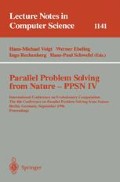Abstract
Using the multi-parent diagonal and scanning crossover in GAs reproduction operators obtain an adjustable arity. Hereby sexuality becomes a graded feature instead of a Boolean one. Our main objective is to relate the performance of GAs to the extent of sexuality used for reproduction on less arbitrary functions then those reported in the current literature. We investigate GA behaviour on Kauffman's NK-landscapes that allow for systematic characterization and user control of ruggedness of the fitness landscape. We test GAs with a varying extent of sexuality, ranging from asexual to ’very sexual’. Our tests were performed on two types of NK-landscapes: landscapes with random and landscapes with nearest neighbour epistasis. For both landscape types we selected landscapes from a range of ruggednesses. The results confirm the superiority of (very) sexual recombination on mildly epistatic problems.
Preview
Unable to display preview. Download preview PDF.
References
T. Bäck and H.-P. Schwefel. An overview of evolutionary algorithms for parameter optimization. Journal of Evolutionary Computation, 1:1–23, 1993.
H.-G. Beyer. Toward a theory of evolution strategies: On the benefits of sex the (Μ/Μ,λ) theory. Journal of Evolutionary Computation, 3(1):81–111, 1995.
A.E. Eiben, P-E. Raué, and Zs. Ruttkay. Genetic algorithms with multi-parent recombination. In Parallel Problem Solving from Nature — 3, LNCS 866, pages 78–87. Springer-Verlag, 1994.
A.E. Eiben and C.H.M. van Kemenade. Performance of multi-parent crossover operators on numerical function optimization problems. Technical Report TR-95-33, also as ftp://ftp.wi.leidenuniv.nl/pub/CS/TechnicalReports/1995/tr95-33.ps.gz, Leiden University, 1995.
A.E. Eiben, C.H.M. van Kemenade, and J.N. Kok. Orgy in the computer: Multiparent reproduction in genetic algorithms. In Third European Conference on Artificial Life, LNAI 929, pages 934–945. Springer-Verlag, 1995.
L.J. Eshelman and J.D. Schaffer. Crossover's niche. In Fifth International Conference on Genetic Algorithms, pages 9–14, 1993.
D.B. Fogel and J. W. Atmar. Comparing genetic operators with gaussian mutations in simulated evolutionary processes using linear systems. Biological Cybernetics, 63:111–114, 1990.
D.B. Fogel and L.C. Stayton. On the effectiveness of crossover in simulated evolutionary optimization. Biosystems, 32:3:171–182, 1994.
W. Hordijk and B. Manderick. The usefulness of recombination. In Third European Conference on Artificial Life, LNAI 929, pages 908–919. Springer-Verlag, 1995.
S.A. Kauffman. Origins of Order: Self-Organization and Selection in Evolution. Oxford University Press, 1993.
B. Manderick, M. de Weger, and P. Spiessens. The genetic algorithm and the structure of the fitness landscape. In Fourth International Conference on Genetic Algorithms, pages 143–150, 1991.
H. Mühlenbein and H.-M. Voigt. Gene pool recombination in genetic algorithms. In Proc. of the Metaheuristics Conference. Kluwer Academic Publishers, 1995.
J.D. Schaffer and L.J. Eshelman. On crossover as an evolutionary viable strategy. In Fourth International Conference on Genetic Algorithms, pages 61–68, 1991.
H.-P. Schwefel. Evolution and Optimum Seeking. Sixth-Generation Computer Technology Series. Wiley, New York, 1995.
J. Smith and T.C. Fogarty. Recombination strategy adaptation via evolution of gene linkage. In Third IEEE Conference on Evolutionary Computation, pages 826–831. IEEE Service Center, 1996.
W.M. Spears. Crossover or mutation? In Foundations of Genetic Algorithms-2, pages 221–238, 1993.
H.-M. Voigt and H. Mühlenbein. Gene pool recombination and utilization of covariances for the Breeder Genetic Algorithm. In Second IEEE Conference on Evolutionary Computation, pages 172–177, 1995.
Author information
Authors and Affiliations
Editor information
Rights and permissions
Copyright information
© 1996 Springer-Verlag Berlin Heidelberg
About this paper
Cite this paper
Eiben, A.E., Schippers, C.A. (1996). Multi-parent's niche: N-ary crossovers on NK-landscapes. In: Voigt, HM., Ebeling, W., Rechenberg, I., Schwefel, HP. (eds) Parallel Problem Solving from Nature — PPSN IV. PPSN 1996. Lecture Notes in Computer Science, vol 1141. Springer, Berlin, Heidelberg. https://doi.org/10.1007/3-540-61723-X_996
Download citation
DOI: https://doi.org/10.1007/3-540-61723-X_996
Published:
Publisher Name: Springer, Berlin, Heidelberg
Print ISBN: 978-3-540-61723-5
Online ISBN: 978-3-540-70668-7
eBook Packages: Springer Book Archive

